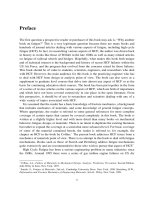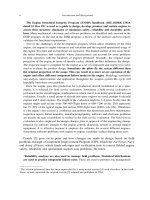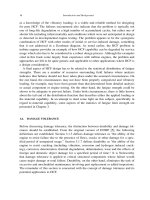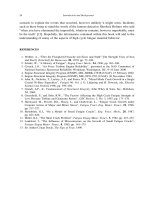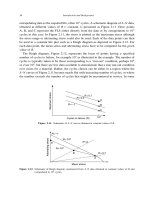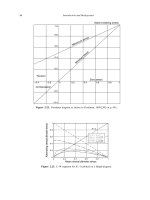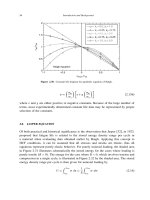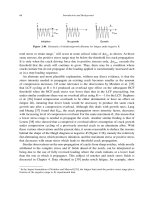Designing a fruit beverages and preserves with a capacity of roughly 20 tons of materials per annum
Bạn đang xem bản rút gọn của tài liệu. Xem và tải ngay bản đầy đủ của tài liệu tại đây (566.06 KB, 117 trang )
ACKNOWLEDGMENTS
I would like to express my appreciation to my supervisor Ph.D. Lai Quoc Dat. I
want to thank him for trusting my skills, for his guidance, advice, and numerous hours
spent helping me throughout this project. I also extend my gratitude to all staffs and
lecturers of the University of Technology, particular all staffs and lecturers at the
Department of Food Technology, Faculty of Chemical Engineering, University of
Technology for giving me knowledge and encouragement since the day I walked in the
university.
My deep and sincere gratitude goes to my parents and my little brother for their
support and unconditional love, without their support and love, this work would not
have been possible.
Finally, I would like to thank my graduate student colleagues in the Department
of Food Technology for their assistance and friendship.
1
SUPERVISOR’S COMMENTS
2
…………………………………………………………………………
…………………………………………………………………………
…………………………………………………………………………
…………………………………………………………………………
…………………………………………………………………………
…………………………………………………………………………
…………………………………………………………………………
…………………………………………………………………………
…………………………………………………………………………
…………………………………………………………………………
…………………………………………………………………………
…………………………………………………………………………
…………………………………………………………………………
…………………………………………………………………………
…………………………………………………………………………
…………………………………………………………………………
…………………………………………………………………………
…………………………………………………………………………
…………………………………………………………………………
…………………………………………………………………………
………………………………….REVIEWER’S COMMENTS
…………………………………………………………………………
…………………………………………………………………………
3
…………………………………………………………………………
…………………………………………………………………………
…………………………………………………………………………
…………………………………………………………………………
…………………………………………………………………………
…………………………………………………………………………
…………………………………………………………………………
…………………………………………………………………………
…………………………………………………………………………
…………………………………………………………………………
…………………………………………………………………………
…………………………………………………………………………
…………………………………………………………………………
…………………………………………………………………………
…………………………………………………………………………
…………………………………………………………………………
…………………………………………………………………………
…………………………………………………………………………
………………………………….
4
INTRODUCTION
In recent years, especially from the beginning of the 2000s, Vietnamese
production areas of fruits and vegetables have developed rapidly and got more and
more specialized. According to report on Vietnamese vegetable and fruit sector, at
present, there are hundreds of vegetable and fruit processing factories and units of
small and medium scale, but only about one fifths of which are for processing fruits.
Vietnam’s fruit production industry is becoming more developed and westernized.
The growth of modern retail formats such as supermarkets presents opportunities for
Vietnamese consumers to be more exposed to high quality and trendy products such as
not from concentrate fruit juice and fruit jam, jelly, … , which are not generally
stocked by traditional stores. The average Vietnamese diet is also changing to include
more fruit and vegetable products. Due to a combination of westernization and rising
health consciousness, both soft drinks and healthy alternatives, such as fruit and
vegetable juices, are expected to grow.
This thesis is about designing a fruit beverages and preserves with a capacity of
roughly 20 tons of materials per annum. A series of preliminary studies have been
taken on all aspects and conditions to determine a final fruit plant design. These
studies would describe the context of the plant design and be developed as follows:
Chapter 1: Socio-economic and technical context for plant design:
-
Information and details as needed to determine the product demand level as
well as production volume according to specifications of the products
evaluated.
-
Availability and location of raw materials, which will have a great influence
on the food plant location and corresponding food processing systems.
Chapter 2: Materials and products
-
Definition and specification of the raw materials.
5
-
Characterization of products (as broad as possible), including technical, legal,
and commercial quality of each food product manufactured.
Chapter 3: Process design:
-
Description of process technology and engineering alternatives, analyzing
their influence on product quality
Chapter 4: Mass balance. Capacity and production planning.
Chapter 5: Machinery and equipment
-
Specifications of food processing equipment and necessary auxiliary
equipment
Chapter 6: Energy balances. Requirements of auxiliary systems:
-
Energy handling systems (steam and refrigeration systems, and electrical
installations).
Chapter 7: Plant building design
-
Hygienic design specifications, concerning food processing equipment and
auxiliary equipment in contact with foods (materials handling)
-
Structures and civil work specifications for outer and interior building
-
Facilities layout
Chapter 8: Electrical System
Chapter 9: Water and waste system
Chapter 10: Organization and management
Chapter 11: Plant Economic
-
6
TABLE OF CONTENTS
7
LIST OF TABLES
8
LIST OF FIGURES
Figure 3. 1 Pineapple line process block diagram
Figure 3. 2 Mango line process block diagram
Figure 3. 3 Orange line process block diagram
Figure 5. 1 Gantt chart of working schedule in orange line
Figure 5. 2 Gantt chart for mango line
Figure 5. 3 Gantt chart for pineapple line
Figure 10. 1 Organizational Structure
9
CHAPTER 1: SOCIO-ECONOMIC AND TECHNICAL CONTEXT
1.1. Socio-economic context
1
Fruit production in Vietnam
Fruit and vegetable production play an important role on the agriculture of many
countries in the world. Fruit and vegetable sector is also an important production
sector of Vietnamese agriculture. Vietnam enjoys numerous favorable conditions for
fruit and vegetable production in which climate and ground are suitable with tropical,
subtropical fruits and some temperate fruits. Vietnamese fruit and vegetable
production in recent years has marked significant progress in both terms of scale and
product structure. Various kinds of special vegetables and fruits with high quality
have been developed and brought high yield thanks to the sector’s application of
advanced cultivation techniques. Vietnamese fruit and vegetable sector has gained
satisfactory achievements in domestic consumption and export. Plentiful processed
products such as canned and condensed fruits have been highly appreciated by
domestic and oversea customers. Especially, some new products such as puree, frozen
vegetables and fruits have been consumed in America and Japan. According to the
latest statistics from the General Department of Customs, from 2007 to 2012,
Vietnam’s vegetables exports grew steadily with the average growth rate of 25 percent
per year and in the first 7 months of 2013, Vietnam’s vegetables and fruit exports
continued to grow with total export turnover of 620.6 million US, increased by 40
percent year by year.
Thanks to the diversified ecology, there are more than 30 different kinds of fruittrees in Vietnam, in which 27 kinds have commercial value, and grown on big land
area, such as orange, mandarin orange, pomelo, pineapple, mango, lemon, jack-fruit,
litchi, etc. Among them, orange and pineapple make up a great density in the total area
of fruit plantation, satisfy domestic consumption and export demands.
Taking advantage of abundant sources of raw materials of high export value,
many fruit processing enterprises in the country have availed themselves of every
opportunity to invest in technology and human resources to process and export fruit
10
products to the world market. Apart from exporting fresh fruit, they have conducted
research to produce many types of processed fruit to provide for the market, such as
dried fruit, moderately dried fruit, salted fruit, frozen fruit, canned fruit, fruit
beverages, fruit preserves and fruit wine. By 2005, the country had a fruit processing
network of more than 60 factories and workshops with a total capacity of over 290,000
tons of finished products per annum. At present, there are hundreds of vegetable and
fruit processing factories and units of small and medium scale, with an average
capacity of roughly 1,000 – 1,500 tons of materials per annum. Two-thirds of which
are for processing vegetable only, about one fifths processing fruits and the remaining
processing both of them.
To develop the practical scale, Vietnam has speeded up the process of planning
areas that have advantages in specially concentrated planting of fruits and vegetables.
In details, Vietnam focuses on growing fruits in the Cuu Long River Delta, Northern
midland and mountainous areas, Central part and Southeast area to effectively solve
the material issue, the most interested issue of many vegetable and fruit processing and
trading enterprises. This solution should accompany with researching, creating new
varieties by crossbreeding, selecting and bringing high quality and productive varieties
into production, using ecological techniques to create clean products to increase the
products’ competitiveness in the integration tendency. Besides, the vegetable and fruit
sector also applies every measure to realize the target of reducing losses after
harvesting to 15% by 2010 such as intensifying the investment, modernizing the
techniques for fresh vegetable and fruit preservation, improving, renovating
techniques, equipment to be suitable with the material area and consumption markets.
2
Fruit production consumption and trend
Vietnam has got a copious domestic fruit consumption market with more than 90
million people. Vietnamese people have habit of consuming a lot of fruits, especially
fresh ones. Processed fruits are drawing more interests of the domestic consumers.
Vietnamese people consume fruits in their daily meals. While the urban people
often eat fresh fruits after meals and processed fruits on the occasions of holidays, the
rural people differ from those in the 28 urban areas; often consume fresh fruits,
11
available in their places, due to their demand and in changeable points of time of the
day. Components fruit consumption varies from region to region. Orange, mango,
pineapple and other fruits are more preferred for consumption in the South.
Vietnamese people are consuming more and more vegetables and fruits; a survey
conducted by the Vietnam Agricultural Science Institute about production and trade of
goods vegetables and fruits show that: Total quantity of consumed vegetables and
fruits per capital has doubled for the past ten years.
Consumption trend of the
Vietnamese people has changed much with a fast increase in domestic demand. If the
quantity of consumed fruits per capita was 38 kg/person/year in 2002, in 2010 it was
67 kg/person/year.
Vietnamese people tend to consume fresh and organic fruits more than processed
ones, but during the process of the country’s industrialization and modernization,
nowadays processed fruits products are accepted by domestic consumers through a big
system of developing supermarkets in urban areas. For the domestic market, the
demand for processed fruit products is increasing rapidly in terms of both quantity and
quality.
The main forms of processed fruit are juice, candied fruit, jams, dried fruit, and
some canned fruits.
3
Availability and location of raw materials
Prior to establishing a new fruit and processing in order to utilize the potential
from the sector, it is essential to determine the potential of pineapple, orange and
mango for the fruit plant by investigating the current and future availability and access
to those raw materials.
In the seven Vietnamese agricultural ecological areas, the biggest fresh fruit
production area is the Cuu Long River Delta. The Cuu Long River Delta accounts for
nearly 40% of the total national fruit production area. In recent years, especially from
the beginning of the 2000s, Vietnamese production areas of fruits and vegetables have
developed rapidly and got more and more specialized due to high demands, the fruit
production area has recently increased very fast. In 2005, it was 766,900 hectares with
an output of 6.5 million tons. According to the Cultivation Department of the Ministry
12
of Agriculture and Rural Development, currently the whole country has approximately
900,000 ha of fruit trees with a total output of about 10 million tons of fruit. Main fruit
trees are citruses, mangoes, pomelos, pineapples, star apples, etc. In 2012, the fruit
production area in Southern provinces was about 460,900 hectares, accounting for
59.43% of the total national fruit production area. The provinces of Tien Giang, Dong
Nai, Vinh Long, Ben Tre and Dong Thap have the largest cultivated areas in the South.
Orange, mango and pineapple were selected as three main ingredients for the
products of the plant.
King Orange: is mainly grown in the Cuu Long River Delta with an area of 28.7
thousand hectares and an output of over 200 thousand tons. The province which has
the highest output is Vinh Long. In 2005, its output was over 47 thousand tons. The
next is Ben Tre province with 45 thousand tons and Tien Giang province with 42
thousand tons. In the Northern midland and mountainous area, the king orange is
grown a lot in Ha Giang province; however, the output is nearly 20 thousand tons.
Mango: currently, there are many varieties of mango planting in Vietnam;
however, the variety that has high quality and is grown in concentrated area is Hoa
Loc sweet mango. This mango is mainly grown along Tien River which is about 20-25
km far from My Thuan Bridge with an area of 4.4 thousand hectares and an output of
22.6 thousand tons. The biggest Hoa Loc sweet mango production area is Tien Giang
province with an area of 1.6 thousand hectares and an output of 10.1 thousand tons.
The next is Dong Thap province with an area of 873 hectares and an output of 4.3
thousand tons.
Pineapple: is one of three main fruit-trees that have been encouraged to develop
for export recently. The main varieties are Queen and Cayenne; in which Cayenne
variety is highly productive, suitable for processing areas that have big pineapple area
are Tien Giang province with 3.7 thousand hectares, Kien Giang province with 3.3
thousand hectares, Nghe An province with 3.1 thousand hectares, Ninh Binh province
with 3.0 thousand hectares and Quang Nam province with 2.7 thousand hectares.
13
1.2. Plant location
The location of the food plant is decided by considering the availability of raw
materials and labor, the access to plant utilities (water, power) and waste treatment or
disposal, the transportation systems, the regulation requirements, and the food
consumption outlets. Fruit processing plant should be located near the agricultural
farms, so that truck transportation will be fast enough to prevent any spoilage of the
sensitive raw materials. Considering some aspects mentioned above, the plant will be
located at Tan Huong Industrial Zone in Tien Giang Province, the largest cultivated
area in the South with the following advantages:
Raw materials and supplies
Because fresh fruits and vegetables are both bulky and spoil rapidly, it is better to
locate a processing plant in the area where they are grown. As mentioned in I.3 above,
Tien Giang is the largest cultivated area with the high output volume of all three main
fruit ingredients of the plant.
Sales and reducing delivery cost to markets.
Tan Huong Industrial Zone is about 50 km away from Ho Chi Minh City and 37
km from other Southern urban center Can Tho Province.
Transportation and distribution by highways, waterways, or airways.
Tan Huong Industrial Zone is about 47 km away from Tan Son Nhat Airport and
45 km away from Hiep Phuoc Harbor. In addition, the zone is near to main road
leading to Ho Chi Minh City and Can Tho for contributing products easily.
Manpower supply
The zone is close to transportation or population center. Tien Giang province has
an availability of skilled manpower, the prevailing wage pattern, living costs and the
industrial relations situation.
Infrastructure
The zone has an availability and reliability of power, water, fuel and
communication facilities
14
1.3. Product design
In planning for starting a new business, the first thing to determine is the likely
demand of each product category. The proportion of the total market that could be
captured by a new business is vital tool for the determination of scale of production
for the processing plant. The estimation of feasible market share of the project was
based
on number
of
competitors, scale
of
production
and
the
product
characteristics.
4
1
Fruit beverages
Product description:
Fruit juice: According to Codex general standard for fruit juices and nectars
(CODEX STAN 247-2005), fruit juice is the unfermented but fermentable liquid
obtained from the edible part of sound, appropriately mature and fresh fruit or of fruit
maintained in sound condition by suitable means including post-harvest surface
treatments applied in accordance with the applicable provisions of the Codex
Alimentarius Commission. Fruit juice can be directly expressed by mechanical
extraction processes or obtained by reconstituting concentrated fruit juice.
Fruit nectar: According to Codex general standard for fruit juices and nectars
(CODEX STAN 247-2005), fruit nectar is the unfermented but fermentable product
obtained by adding water with or without the addition of sugars or food additive
sweeteners to a mixture of those products. Aromatic substances, volatile flavor
components, pulp and cell all of which must be recovered from the same kind of fruit
and be obtained by suitable physical means may be added. Mango nectar is defined as
the dilution of pure, single strength mango pulp with sugar, water or preservatives to
make a beverage that has a certain percentage of pure mango pulp. According to the
Codex Alimentarius, the actual percentage of pure juice product in the nectar must be
noted on the label: i.e. “this nectar contains at least 30% pure mango pulp”.
Mangoes are also processed into purée for re-manufacturing into products
such as nectar, jam. The purée is preserved by chemical means and stored in barrels.
15
This allows a supply of raw materials during the remainder of the year when fresh
mangoes are not available.
2
Product quality criteria
Fruit beverages products of the plant must meet the following quality criteria:
Table 1.1: Quality criteria for fruit juices and nectar (CODEX STAN 247-2005).
Specification
Requirements
Flavor, aroma and color.
The fruit juices shall have the characteristic color,
aroma and flavor of juice from the same kind of
fruit from which it is made.
Physical and chemical criteria
Brix value
Orange juice
14oBrix
Pineapple juice
16oBrix
Contaminants
≤ 0.5 %
Residue on Ignition
≤ 0.05 %
Oxalate/Oxalic Acid
≤ 0.036 %
Sulfate (%)
≤ 0.015 %
Arsenic
≤ 1 ppm
Heavy metals
≤ 5 ppm
Lead
≤ 0.5 ppm
Microorganism criteria
5
1
Total plate count, cfu/g
103
Staphylococcus aureus, cfu/g max
102
Escherichia coli, cfu/g, max.
30
Salmonella, per 25g, max.
Not detected
Shigella, cfu/g, max
Not detected
Yeasts and moulds, cfu/g, max
50
Streptococcus hemolytica,cfu/g, max.
Not detected
Fruit Jam
Product description
According to Codex standard for jams, jellies and marmalades (CODEX STAN
296 - 2009), fruit jam is the product brought to a suitable consistency, made from the
16
whole fruit, pieces of fruit, the concentrated fruit pulp or fruit puree, of one or more
kinds of fruit, which is mixed with sweetening and gelling agents.
2
Quality criteria
The requirements for jam are set out in the following standard:
Table 1.2: Quality criteria for fruit jam (CODEX STAN 296 - 2009).
Specification
Requirements
Appropriate gelled consistency.
Having normal color and flavor appropriate to the type or
kind of fruit ingredient used in the preparation of the
General requirements
mixture
Free from defective materials normally associated with
fruits.
Physical and chemical criteria
The soluble solids content
60 – 65% or greater.
Contaminants
≤ 0.5 %
Residue on Ignition
≤ 0.05 %
Oxalate/Oxalic Acid
≤ 0.036 %
Sulfate (%)
≤ 0.015 %
Arsenic
≤ 1 ppm
Heavy metals
≤ 5 ppm
≤ 0.5 ppm
Lead
Microorganism criteria
Total plate count, cfu/g
103
Staphylococcus aureus, cfu/g max
102
Escherichia coli, cfu/g, max.
30
Salmonella, per 25g, max.
Not detected
Shigella, cfu/g, max
Not detected
Yeasts and molds, cfu/g, max
6
1
50
Orange concentrate
Product description
17
Orange concentrate is produced when it is at the peak season of orange (from
August to January). The process of concentration consists of the physical removal of
water until the product has a soluble orange solids content of 65 oBrix. The regulations
concerning of essential compositions and quality factors are given by Codex standard
for concentrated orange juice preserved.
2
Product criteria
Table 1.3: Quality criteria of orange concentrate juice (CODEX STAN 64-1981)
Specification
Requirements
Physical and chemical criteria
Soluble solids content
65oBrix
Contaminants
≤ 0.5 %
Residue on Ignition
≤ 0.05 %
Oxalate/Oxalic Acid
≤ 0.036 %
Sulfate (%)
≤ 0.015 %
Arsenic
≤ 1 ppm
Heavy metals
≤ 5 ppm
Lead
≤ 0.5 ppm
Microorganism criteria
Total plate count, cfu/g
103
Staphylococcus aureus, cfu/g max
102
Escherichia coli, cfu/g, max.
30
Salmonella, per 25g, max.
Not detected
Shigella, cfu/g, max
Not detected
Yeasts and molds, cfu/g, max
50
Streptococcus hemolytica, cfu/g, max.
Not detected
1.4. Plant capacity
7
Fruit beverages
A large choice of fruit beverages such as juice, nectar…is available in
supermarkets, as well as in many smaller shops. Examples include apple, orange,
pineapple, mango juice. The most common fruit juices are orange, apple and mixed
18
fruit juices, which are available from a variety of brands. Canned sweetened fruit juice
drinks are mainly imported from Malaysia, Thailand and Singapore, though a few
domestic products are also available.
Data obtained from Euromonitor International Official Statistics indicates that the
total amount of consumed fruit beverages in Vietnam reached 53.3 million liters in
2010 with a prediction that the volume of consumed fruit beverages in Vietnam will
reach 76.6 million liters at a growth rate of 121.3 %.
The plant’s fruit beverages products would encounter competition from many
local suppliers. Hence, a market share of about 5% could be assumed to be captured.
The estimation of fruit beverages capacity: 76.6 × 5% = 3.83 million liters/year.
Table 1.4: Fruit beverages capacity
8
Products
Capacity (thousand liters/year)
Orange juice
1200
Pineapple juice
1200
Mango nectar
1200
Fruit preserves
Fruit preserves such as jam, jelly and marmalade are widely used by household,
hotels, restaurants, boarding schools and hospitals, as bread dressing and in pastries to
sweeten cakes. The demand for jam, jelly and marmalade is increasing as a derive
demand due to increasing consumption of jam as bread dressings. Fast rising of
pastries and standard hotels also contribute to the increase consumption of these
products. Fruit jam mainly sold in supermarkets, is largely imported, though the
number of domestically produced jams seems to be increasing. The largest domestic
producer appears to be Les Vergers du Mekong, offering a variety of fruit jams such as
strawberry, plum, pineapple, guava, raspberry, pomelo, mandarin, and papaya. A few
small shops also sell home-made jams made from pineapple, plums, oranges, and other
fruits. This indicates that there is an opportunity for producing these products through
local production.
19
Mango and pineapple jams would encounter competition from local and imported
jams. Because there has not had a detail report of the amount of jam production
volume in market, the capacity of jams could be assumed to be about 2,100 tons/year.
Table 1.5: Fruit jam capacity
Products
Capacity (tons/year)
Mango jam
900
Pineapple jam
1,200
20
CHAPTER 2: MATERIALS
2.1. Fruits
9
Orange
The orange is the fruit of the citrus species Citrus sinensis in the family Rutaceae.
The fruit of the Citrus sinensis is called sweet orange to distinguish it from that of the
Citrus aurantium, the bitter orange.
As the demand for oranges is always high in Vietnam, the prospect of large-scale
cultivation of orange is good. Although climatic conditions in the South are not
favorable to produce high quality oranges for fresh consumption, tropical climate
favors vigorous growth, and sweet fruit. This would be ideal for orange juice from
King Orange. King oranges are harvest during a year but peak season is from August
to January. Only raw materials are allowed for fruit drink production that meet the
plant’s purchasing requirements based on Codex standard for oranges (CODEX STAN
245-2004):
Minimum requirements
The oranges must be whole, clean, practically free of any visible foreign matter;
practically free of pests and damaged caused by pests, free of any foreign smell and
taste; free of damage caused by low or high temperatures.
Maturity criteria
Color: oranges appear as green and greenish yellow. Oranges produced in the
South with high air temperatures and high relative humidity conditions during the
developing period can be of a green color exceeding one fifth of the total surface area.
Orange’s maturity can be determined by the ratio of total soluble solids (B) and
percentage of citric acid (A). In the case of tropical climate, a B/A ratio of 10 to 16 is
the standard.
Sizing
21
The average diameter of the equatorial section of the reception fruits is about 5070 mm. The maximum difference between the smallest and the largest fruit must not
exceed the maxima of 10 mm.
Minimum Juice Content: 35%.
10
Pineapple
Pineapple (Ananas comosus) is widely grown in many tropical countries for
domestic consumption or for export, either fresh or processed. It is the second (after
banana) most important fruit of Vietnam in terms of area planted and production and
the most important one in terms of processed fruit. Pineapple is consumed as fresh
or processed traditionally. The ripe fruits are utilized in making pulp, puree, nectar,
squash, leather, slices,…
Pineapple purchasing requirements are based on Codex standard for pineapples
(CODEX STAN 182-1993).
Minimum requirements:
-
The pineapples must be whole, without the crown, clean.
-
Firmness.
-
Freedom from decay.
-
Freedom from sunburn, sunscald, cracks, bruising, internal browning,
endogenous brown spot, gummosis, and insect damage.
Maturity criteria:
The shell colors of pineapple are generally used to determine the various stages of
maturity. Smooth Cayenne produces a light yellow or golden yellow color when ripe.
Fruits with no yellowing are not mature enough for optimum quality. The fruit surface
color is the one – quarter to one – half yellow.
11
Mango
Mango fruits are very much relished for their, exotic flavor and delicious taste.
They are also an excellent source of dietary fiber, provitamin A and vitamin C. A fruit
with many versatile properties has naturally found application for processing into
22
several products. Ripe mangoes are processed as canned and frozen slices, purée,
juices, nectar, jam, jelly and various dried products.
Mangoes purchasing requirements are based on Codex standard for mangoes:
Minimum requirements:
The mangoes must be whole, clean and fresh in appearance, practically free of
damage caused by low temperatures, free of lack necrotic stains and marked bruising.
The mangoes must be sufficiently developed and display satisfactory ripeness. When a
peduncle is present, it shall be no longer than 1.0 cm.
Maturity criteria:
-
The fruit surface color is the one – quarter to one – half yellow
-
The total soluble solids content in the fruit flesh should be at least 12°Brix.
For the determination of Brix degrees a representative sample of the juice of
all the fruit shall be taken.
2.2. Auxiliary materials
12
Sugar
Sugar is the conventional name applied to sucrose. Sugar is used as a sweetener in
juice line. For jam production, sugar provides taste, flavor, consistency and coloring.
Table 2.1: Composition requirements for white sugar.
Characteristic
Requirement/limit
Polarization, °Z, min
99.7
Invert sugar content, % m/m, max
0.04
Sulfate ash
0.06
Conductivity ash, % max
0.04
Moisture content, max
0.05
Color, in ICUMSA units, max
60
Sulfur dioxide, mg/kg, max.
15
Sugar is used its granulated form, this quality must be in the form of uniform
crystals, white, shining and completely soluble in water. The quality of purchased
23
sugar must meet the following criteria based on Codex standard for sugars (CODEX
STAN 212-1999).
Table 2.2: Maximum levels for metal contaminants.
Parameters
Requirement
Arsenic (As) mg/kg, max
0.5 mg/kg
Copper (Cu) mg/kg, max
2 mg/kg
Lead (Pb) mg/kg, max
0.5 mg/kg
Table 2.3: Microbiological limits for white sugar.
Microorganism(s)
Total plate count, cfu/g
103
Staphylococcus aureus, cfu/g max
102
Escherichia coli, cfu/g, max.
30
Salmonella, per 25g, max.
Not detected
Shigella, cfu/g, max
Not detected
Yeasts and moulds, cfu/g, max
Streptococcus hemolytica, cfu/g, max.
13
Requirement
50
Not detected
Pectin
Pectin is an important gelling agent used in manufacturing fruits jam. Pectin is a
class of complex hetero polysaccharides found in the cell walls of higher plants, where
they function as a hydrating agent and cementing material for the cellulosic network.
Its importance in the jam processing lies in its ability to form gel in the presence of
Ca2+ ions or a solute at low pH. Although present in the cell walls of most plants apple
pomace and orange peel are the two major sources of commercial pectin due to the
poor gelling behavior of pectin from other sources.
Pectin powder purchased from the suppliers must meet the following requirements
of the plant:
Table 2.4: Requirements of the purchased pectin.
Specification
Requirements
24
14
Viscosity of 1% solution
40 - 60 cps
Moisture
≤ 10%
Acid insoluble ash
≤ 10%
Galocturonic acid content
≥ 75%
Total Plate Count
≤ 1000 cfu/g
Yeast and Mold
≤ 100 cfu/g
Coliforms
≤ 0.3 cfu/g
Salmonella
Negative in 25 g
Arsenic
≤ 3 ppm
Lead
≤ 5 ppm
Acidulants
Acidulants are acids that either occur naturally in fruits and vegetables or are used
as additives in food processing. Acidulants serve many functions in fruit processing.
They perform a variety of functions in fruit processing, the primary being acidifier, pH
regulator, preservative and curing agent, flavoring agent, chelating agent, buffering
agent, gelling agent, and antioxidant synergist. Citric acid is purchased to the plant as
an acidulant for fruit beverages and preserves production.
Citric acid is slightly hydroscopic, available as translucent white crystals and has a
tart acidic taste. Citric acid melts at 153°C. Citric acid is used as an acidifier and
flavoring agent in fruit beverages line. It is also used in fruit jam production due to its
taste, antioxidant and gelling characteristics, solubility, storage and handling
characteristics. Moreover, citric acid can also be added at a late stage of process to
give precise pH control.
Table 2.5: Requirements for the purchased citric acid.
Specification
Requirements
Assay
≥ 99.5 %
Moisture
≤ 0.5 %
Residue on Ignition
≤ 0.05 %
Sulfate (%)
≤ 0.015 %
Arsenic
≤ 1 ppm
25


